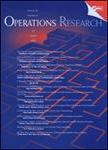-
作者:DESROCHERS, M; DESROSIERS, J; SOLOMON, M
作者单位:Universite de Montreal; Universite de Montreal; HEC Montreal; Universite de Montreal; Polytechnique Montreal; Northeastern University
摘要:The vehicle routing problem with time windows (VRPTW) is a generalization of the vehicle routing problem where the service of a customer can begin within the time window defined by the earliest and the latest times when the customer will permit the start of service. In this paper, we present the development of a new optimization algorithm for its solution. The LP relaxation of the set partitioning formulation of the VRPTW is solved by column generation. Feasible columns are added as needed by ...
-
作者:AGNIHOTHRI, SR; KARMARKAR, US
作者单位:University of Rochester
摘要:Field service support is important for certain products, such as computer systems and copiers, for which service performance has a significant impact on market share. In this paper, the problem of field service operations and its important characteristics are described. Models are developed to assist the field service manager in the evaluation of performance of a given service territory with heterogeneous machines scattered (typically, nonuniformly) over a region, repaired by a traveling servi...
-
作者:XU, SH
摘要:This paper considers a stochastic system where a fixed number of nonpreemptive jobs (no new jobs arrive) are to be processed on multiple nonidentical processors. Each processor has an increasing hazard rate processing time distribution and the processors are ordered in ascending order of their expected processing times. It is shown that the policy which minimizes the total expected delay of all the jobs (flowtime) has a threshold structure. This policy would utilize the fastest available proce...
-
作者:HIRAYAMA, T; KIJIMA, M
作者单位:University of Tsukuba
摘要:We consider single machine scheduling problems when the machine capacity varies stochastically over time. Suppose that R(t) greater-than-or-equal-to 0 processing requirements can be processed per unit of time at time t. First, we treat the general meachine capacity R(t) and then consider the machine breakdown models where R(t) = 0 or 1. Jobs may arrive according to an arbitrary process. We show that simple priority rules are optimal under some assumptions. Specifically, the c-mu rule minimizes...
-
作者:FEDERGRUEN, A; ZHENG, YS
作者单位:University of Pennsylvania
摘要:We consider inventory systems with several distinct items. Demands occur at constant, item specific rates. The items are interdependent because of jointly incurred fixed procurement costs: The joint cost structure reflects general economies of scale, merely assuming a monotonicity and concavity (submodularity) property. Under a power-of-two policy each item is replenished with constant reorder intervals which are power-of-two multiples of some fixed or variable base planning period. Our main r...
-
作者:HENIG, MI; LEVIN, N
摘要:We consider a producer who turns a raw material into a product. Before embarking upon production, the producer has to consider the quantity of raw material to order and the finished product delivery commitments; the actual amount produced is a random multiple of the amount of raw material ordered. A concave expected profit function is introduced which gives rise to simple formulas for determining the optimal quantities to order and to commit for delivery. We also analyze the relations between ...
-
作者:SEIERSTAD, A
摘要:In an optimal stopping problem where bids on an asset are received, conditions are given that ensure the so-called reservation price property, namely, if a certain price is accepted, then any higher price would also have been accepted at that point in time. The approach followed in this paper is similar to that pursued by D. B. Rosenfield and R. D. Shapiro in 1981.
-
作者:GOYAL, SK
摘要:In this note, a simple procedure is given for determining the optimal ordering policy for an item for which an increase in the price has been announced. The procedure eliminates the need for evaluation and comparison of the total costs of alternate ordering policies for determining the optimal ordering policy.

